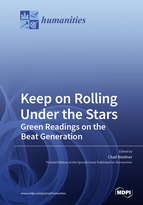Keep on Rolling Under the Stars: Green Readings on the Beat Generation
A special issue of Humanities (ISSN 2076-0787). This special issue belongs to the section "Literature in the Humanities".
Deadline for manuscript submissions: closed (31 January 2021) | Viewed by 29430
Special Issue Editor
Special Issue Information
Dear Colleague,
The Beat Generation promoted transnational literatures of resistance, and green readings of their work remains lacking. The Beat Generation was a transnational group of literary bohemians, and the relevance of their work might seem limited to the immediate postwar period. The problem of climate change has long been a source of inspiration for authors, and existing scholarship acknowledges this fact. Nonetheless, important questions remain. Can the environmental humanities contribute to current debates surrounding the Beat Generation? Can scholarly activities help resolve the many aesthetic and moral questions the Beat Generation confronts us with? Grace and Skerl argue as recently as 2018 that there is still a need for wider academic recognition of the Beat project, and recent trends in the environmental humanities can bring new conceptual and theoretical understanding to the Beat project. While the environmental humanities have made a broad intervention into literature over the past decades, what remains surprising is the lack of engagement with the profound philosophical and literary movement of the Beats. Connecting ecology to the Beats should not be that surprising. In his pioneering 1995 study, Steven Watson noted key aspects of the Beat Generation that resonate today, including the "spread of ecological consciousness," a wider "opposition to the military-industrial machine civilization," "[r]espect for land and indigenous peoples, and "[l]ess rich conspicuous consumption" (304). History suggests that Gary Snyder, Jack Kerouac, and Michael McClure are the Beat writers most clearly interested in finding some kind of "reconnection with the natural world" (Phillips 125). Interesting too is that William Burroughs at times also expressed a deep "yearning for a return to a more pastoral—and even, at times, more primitive—existence" (125). Gregory Stephenson further maintains that the influence of the Beat Generation may be discerned in nearly every aspect of the counterculture, including the denunciation of material concerns and careerism, increasing pacifism, and even a green anarchist philosophy that echoes Thoreau. Thus, it would seem that green readings on writers affiliated with the Beat Generation can benefit from reconsideration. Gary Snyder holds a prominent position in Beat lore and is widely acknowledged for his green poetic vision, but more research "might challenge stereotypical views of the Beats as hedonists who also happened to write" (Weidner 164). This Special Issue welcomes green readings on the Beats defined in a very broad sense, and includes not just the core members, but also women, the post-Beats, and contemporary writers, artists, and musicians that are heavily influenced by the Beat project. As such, this Special Issue seeks to trace the ecological arc of the Beats from the earliest manifestations to the present day.
References:
Grace, Nancy M. and Jennie Skerl. "Afterword 'Standing at a Juncture of Planes'." Hip Sublime, edited by Sheila Murnaghan and Ralph M. Rosen, Ohio State UP, 2018, pp. 271-276. Beat Writers and the Classical Tradition, JSTOR, http://0-www-jstor-org.brum.beds.ac.uk/stable/j.ctt2204rr5.17.
Newhouse, Thomas. The Beat Generation and the Popular Novel in the United States, 1945-1970. Jefferson, N.C.: McFarland, 2000.
Phillips, Rod. "Forest Beatniks" and "Urban Thoreaus": Gary Snyder, Jack Kerouac, Lew Welch, and Michael McClure. Modern American Literature. New York: P. Lang, 2000.
Stephenson, Gregory. The Daybreak Boys: Essays on the Literature of the Beat Generation. Carbondale: Southern Illinois UP, 1990.
Watson, Steven. The Birth of the Beat Generation: Visionaries, Rebels, and Hipsters, 1944--1960. New York: Pantheon, 1995.
Weidner, Chad. The Green Ghost: William Burroughs and the Ecological Mind. Carbondale: Southern Illinois UP, 2016.
Dr. Chad Weidner
Guest Editor
Manuscript Submission Information
Manuscripts should be submitted online at www.mdpi.com by registering and logging in to this website. Once you are registered, click here to go to the submission form. Manuscripts can be submitted until the deadline. All papers will be peer-reviewed. Accepted papers will be published continuously in the journal (as soon as accepted) and will be listed together on the special issue website. Research articles, review articles as well as short communications are invited. For planned papers, a title and short abstract (about 100 words) can be sent to the Editorial Office for announcement on this website.
Submitted manuscripts should not have been published previously, nor be under consideration for publication elsewhere (except conference proceedings papers). All manuscripts are thoroughly refereed through a double-blind peer-review process. A guide for authors and other relevant information for submission of manuscripts is available on the Instructions for Authors page. Humanities is an international peer-reviewed open access quarterly journal published by MDPI.
Please visit the Instructions for Authors page before submitting a manuscript. Submitted papers should be well formatted and use good English. Authors may use MDPI's English editing service prior to publication or during author revisions.
Keywords
- The Beat Generation
- transnational literatures
- green readings
- literary bohemians
- climate change
- environmental humanities






